Kangaroo Paws are a beautiful addition to any Australian garden, filling it with colourful flowers and bold foliage through the seasons. Find out how to grow Kangaroo Paws and care for these pretty native plants in our ultimate growing guide.
More...
Genus: | Anigozanthos |
|---|---|
Common Names: | Kangaroo Paw, Catspaw |
Family: | Haemodoraceae |
Location: | Outdoor |
Type: | Herbaceous perennial |
Growth: | 1mx1m |
Sun requirements: | Full sun |
Foliage Colour: | Green |
Flower Colour: | Orange / Red |
Flowering: | Spring - Winter |
Fruits: | None |
Maintenance level: | Low |
Poisonous for pets: | Non-toxic to cats and dogs |
What is a Kangaroo Paw Plant?
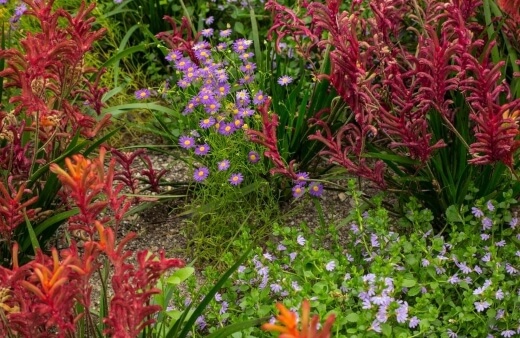
Anigozanthos, also known as Kangaroo Paw plants, are a beautiful, easy and rewarding plant to grow in your garden. As an Australian native plant, it’s well-suited to the environment and climate, filling gardens with bright, long-stemmed flowers through the spring and summer.
There are many different varieties of Kangaroo Paws that you can plant, largely due to the efforts of breeder Angus Stewart. This includes varieties with improved form, improved disease resistance, different colour flowers and different size plants.
They grow quickly and can reach 40cm to a couple of metres tall depending on the variety, are low maintenance and are a good choice for cut flowers, native gardens, inexperienced gardeners, and drought-friendly gardens.
They are easily identifiable, with long, slender arching leaves (similar to daylilies) and producing fans of tubular flowers on multiple stalks. It is this fan of flowers that gives it the look of an animal paw, and is where the name Kangaroo Paws originates.
Kangaroo Paw Plant’s Natural Habitat
Kangaroo paw plants are native to south-western Australia, thriving everywhere from Mount Barker right up to the Murchison River.
While they are one of our favourite native plants they are also grown as houseplants in the Northern Hemisphere and many are half-hardy as outdoor plants in cooler climates.
Kangaroo paw plants grow naturally in free draining but moist soil, and are happiest with a slight breeze, so exposed sunny positions are ideal, mimicking their natural environment growing as solitary evergreen perennial plants with tough leaves, and flower stems that naturally die back each year.
Best Kangaroo Paw Plant Varieties
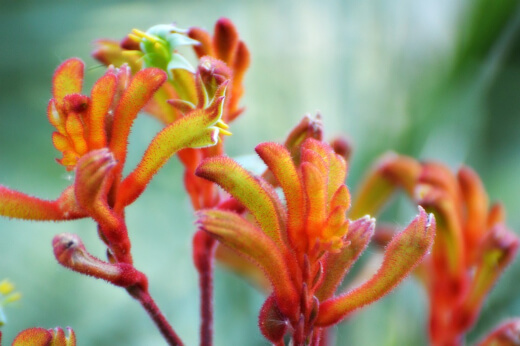
When choosing a Kangaroo Paw plant, it’s important to consider the size of the variety and the colour, if you want the plant to fit into your garden well.
Tall varieties tend to have a longer lifespan than more compact varieties, which generally last about 3 seasons.
Some of the most successful varieties of Kangaroo Paw include:
Red & Green Kangaroo Paw (Anigozanthos manglesii)
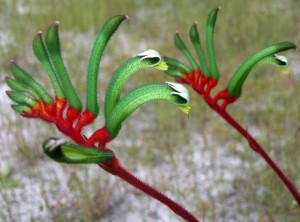
Bright flowers of red and green, this is a bold flower that is ideal for mass planting. It’s also the floral emblem of Western Australia. Flowering from late winter through summer, it’s flower stems reach about 1m in height with a width of about 50cm.
The Anigozanthos manglesii is happiest in a position that receives full sun. When in good conditions this variety really thrives and will grow to have flowering stems up to 1 metre in height.
This plant will usually last for a few flowering seasons, normally up to 3 or 4, but is not a bad idea to replace after the 2nd flowering season.


Get Your Free Guide:
Master Growing Australian Natives eBook
A Must Have Complete Guide for Every Australian Garden
Get Your Free Guide:
Master Growing Australian Natives eBook
A Must Have Complete Guide for Every Australian Garden
The bold red and green coloured flower really helps it stand out when mixed with other varieties but can also look absolutely fantastic if many of the same variety are planted together.
I once saw a great example of this just outside Kings Park in Western Australia. A whole batch, no less than 100 plants I would say, were planted close together on an island in the road and really made quite an impression on passing motorists.
A tip with any Kangaroo Paw is to remove the stems after flowering as this promotes new growth and speeds up the next batch of flowers.
Kangaroo Paw Ruby Velvet (Anigozanthos ‘Ruby Velvet’)
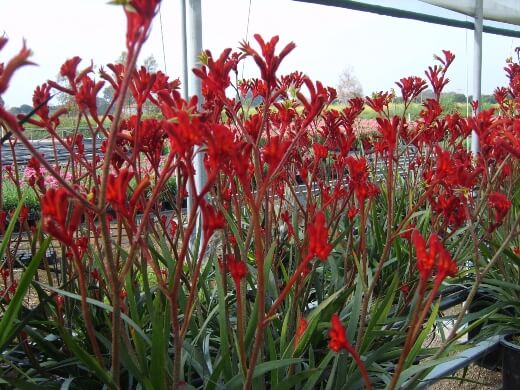
Source: digplantco.com
With abundant deep red flowers from August to May, this is a smaller, more compact variety that grows to about 40cm high and 30cm wide. It grows well in pots as well as in flowerbeds, is frost and drought tolerant, and generally lives 3 years or more.
Kangaroo Paw Orange Gem (Anigozanthos ‘Orange Gem’)
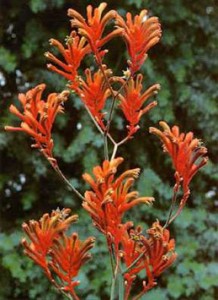
With orange-red flowers through spring and summer, this is a smaller variety that grows to a maximum height of 50cm and width of 50cm, making it a great border plant.
The Anigozanthos flavidus actually comes in a few different sub-species but the best sub-species boats beautiful orangey red flowers, so that is the variety that I am recommending.
This variety is generally smaller than manglesii (red and green), normally growing no higher than 50cm so if you are planting it together with that variety it is best to be placed on the outside.
This variety makes for an absolutely fantastic border plant as well, especially along the side of a path from your front gate to your front door. Attracts birds, in particular the honey eater. I have grown this variety and have always been very happy with the results. Install a bird bath nearby, as the birds will rest on the kangaroo paws before having a drink.
The fact that is also has a slightly different flowering season to the manglesii means if planted together (perhaps with some other varieties as well) you are increasing the chances of having at least a few of your Kangaroo Paws flowering at any given time of the year!
Kangaroo Paw Bush Pearl (Anigozanthos ‘Bush Pearl’)
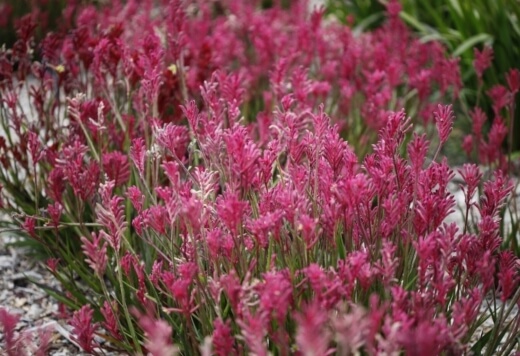
Source: guildfordgardencentre.com.au
This is a vibrant pink variety that is ideal for container planting although it grows well in mass-planted flowerbeds too. It flowers year-round and grows to about 60cm high and 50cm wide. It tolerates light frost and drought, and produces beautiful cut flowers.
Kangaroo Paw Green Machine (Anigozanthos ‘Green Machine’)
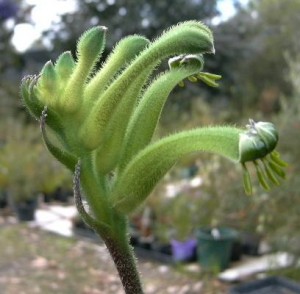
A more unusual variety, the Green machine has vibrant green flowers through spring and summer with stems up to 1m and a spread of up to 1m. It works best when planted together with another colour Kangaroo Paw plant to create a strong contrast.
This variety is another of the larger in the Anigozanthos genus, with flowering stems up to 1m high. Obviously the main difference between this species and the others is it has green flowers as well as foliage.
However what is great about this variety is the green flower is a much lighter green colour than the stems. The best use I have seen for this variety is when placed between two other varieties.
For example I once saw a patch of Red and Green Kangaroo paws clumped together, surrounded by the viridis Kangaroo paws and then another, smaller variety with yellow flowers.
The light green flowers of the viridis really helped to create an amazing visual contrast between the Red & Green and Yellow flowering varieties.
Having said this I would say the viridis doesn’t look as good by itself, so it is best when planted amongst other varieties.
Kangaroo Paw Amber Velvet (Anigozanthos ‘Amber Velvet’)
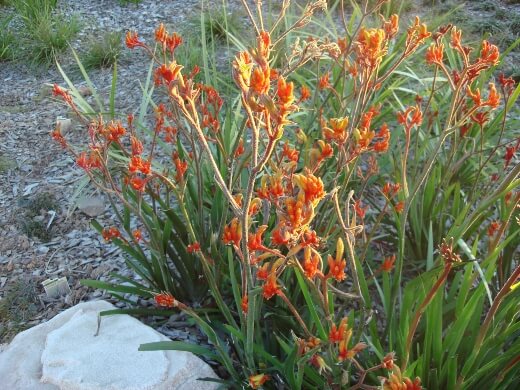
Source: emerisa.com
This variety has fiery red-orange flowers that reach an impressive 1 metre in height. The plant itself grows about 50cm high and 40cm wide and creates a stunning focal point for any garden.
Kangaroo Paw Yellow Gem (Anigozanthos ‘Yellow Gem’)

With deep yellow flowers that occur prolifically through the spring and summer, this is a great variety for smaller gardens, rockeries and container planting.
It grows to about 80cm high and 50 cm wide, attracting birds and butterflies to your garden. This variety is “a hybrid kangaroo paw bred by Mr S Haynes and released in the early 1970’s”.
I myself have not grown this variety so am recommending it based on the picture alone! From its description it certainly sounds like one a very tall growing variety, with flowering stems as large as 1.8m tall!
This is very tall for a Kangaroo Paw! Like most Kangaroo Paws it will grow best in a full sun position.
Kangaroo Paw Landscape Lilac (Anigozanthos ‘Landscape Lilac’)
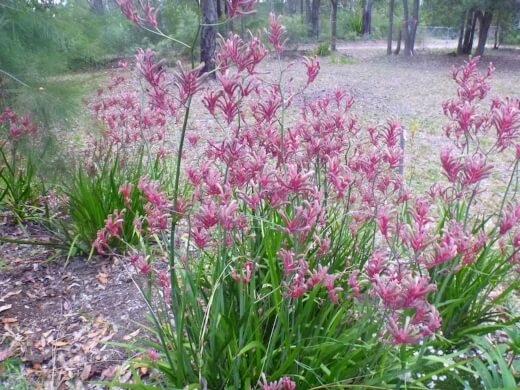
Source: gardendrum.com
This is a very tough and hardy variety with pale purple flowers through spring and summer. A very tall plant and fast-grower that has a longer lifespan, it can reach heights of 2m and a width of 1 metre.
Frost and drought tolerant, this is a great cut flower that the bees and birds love.
How to Grow a Kangaroo Paw Plant
Because they are native to Australia, Kangaroo Paw care is pretty simple if you get the basics right.

Sunlight Preference
Although most varieties can tolerate semi-shade conditions, these plants love full sun and will thrive in a spot where they get 6 hours per day.
They can easily handle hot afternoon sun too. If they don’t get enough sun, they will produce few flowers and the plant may fall over.
Watering Schedule
These are fairly drought-tolerant plants but they do need some watering, especially in the first 3-4 months after planting. They should never ever sit in water or waterlogged/soggy soil, however, as this can quickly result in root rot.
Rather water sparingly about once a week or when the first few centimetres of soil are dry.
Best Soil for Kangaroo Paw
These plants like sandy, well-drained soil with a slightly acidic pH, but can tolerate almost any garden soil as long as it is loose and drains easily.
You can improve your soil before planting your kangaroo plants by adding lots of mulch and organic matter.
Temperature
Kangaroo Paws are happy in all Australian climates and all seasons, although a strong frost may damage or kill them. They like dry conditions but do well in more humid environments as well.
Kangaroo Paw Fertiliser
Because it is a native plant, it requires little or no fertiliser, although a dose of a slow release low phosphorus fertiliser like a 13-2-13, a 14-0-14 or a native blend fertiliser in the spring is recommended.
The best way to feed these plants is to prepare your soil well before planting.
How to Propagate Kangaroo Paw Plant
Kangaroo plants can be propagated from seed or by dividing up an established clump of plants. Here’s what to do.

Growing Kangaroo Plants from Seed
Growing kangaroo paw plants from seed is simple. As long as you try to mimic their natural habitat you can’t go wrong. Follow our instructions for sowing kangaroo paw plants below:
- Fill a seed tray with loose, free-draining compost – ideally seed compost.
- Water the compost before planting your seed to improve contact
- Sow seeds thinly (about 2-3cm apart)
- Do not cover, and kangaroo paw seeds need light to germinate.
- Place it on a sunny windowsill anytime from spring to summer.
- Germination can take up to six weeks
- Keep the soil moist by misting it with tap water, or rainwater.
Propagating Kangaroo Plants from Division
Well-established Kangaroo Paws can be divided into several new plants easily. The best time to do this is in the spring or autumn.
- Using a garden fork, gently lift the Kangaroo Paw plant out of the soil.
- Using a clean, sharp knife, cut away a piece of the plant through the root structure and gently pull it free.
- Cut the leaves back by a third and plant it directly into a prepared flowerbed or container.
- You should see new growth within a week or two.
How to Prune Kangaroo Paw Plants
Kangaroo Paw pruning easier than you think, and the plants respond well to heavy pruning. However, for most gardens, you can follow these instructions:
- Once the flowering season is over, use a clean pair of secateurs to cut back the entire plant. (See our review of the best secateurs in Australia)
- You can leave the leaf growth if the plant looks healthy, just removing dead leaves, but you should do a full prune of the entire plant, leaving about 1/3rd of the plant remaining at least once every two years.
- Cut the flower stalks right down to about 3cm off the ground at a 45° angle.
- Be careful to avoid cutting new buds and fresh stalks. In some cases, a heavy Kangaroo Paw pruning can result in a second flush of flowers in autumn.
When is the Right Time to Prune Kangaroo Paws?
Wondering when to prune Kangaroo Paws? The best time of year to tackle this job is late summer or early autumn, as soon as you notice that flowering has died off for the most part.
Why is Kangaroo Paw Pruning Important?
This heavy pruning is a great way to stimulate strong, vigorous growth in the spring, helping the plant produce plenty of dense foliage. Kangaroo Paw pruning is also an important disease prevention step, as it removes old foliage that can quickly become infected.
In some parts of Australia, old foliage is also a fire risk and should be removed before it dries into tinder.
Common Kangaroo Paw Pests and Diseases
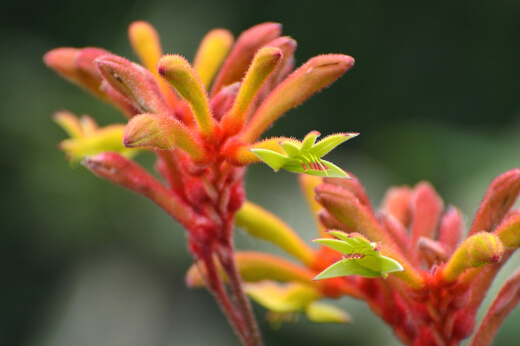
As native plants, Kangaroo Paws are fairly healthy and resistant to pests and diseases, which makes them very low maintenance plants and a favourite for parks, walkways and gardens. However, there are a couple of things you should watch out for.
Black Ink Spot Disease
This disease kills leaf tissue, causing spots that look like small drops of black ink on the foliage. It is caused by a fungal infection, and can be controlled by cutting away infected foliage, spraying with a fungicide, and pruning your plants well each year.
Fungi love moisture, so you can prevent this issue by watering less in summer and only watering in the early morning.
Rust
Another fungal disease, rust causes orangey-brown blisters on foliage. It can be treated with neem oil or fungicide, and can be prevented by a good annual pruning and reduced watering through the warmer months.
Plants that are stressed by their environment are more likely to develop rust, so make sure your plant is getting enough sun and that the soil is draining properly.
Crown and root rot
Overwatering can quickly cause crown and root rot, especially if the soil is soggy and drains poorly. Good air flow, sufficient sunlight and only watering when needed will prevent this problem.
Snails or slugs
These creatures love Kangaroo Plants and can quickly damage the foliage. The best controls are environmental controls rather than snail bait.
Rather than letting poisons get into the environment, remove snails and slugs by hand, encourage natural predators and sprinkle used coffee grounds onto the soil.
Kangaroo Paw Frequently Asked Questions

Can a kangaroo paw be an indoor plant?
Kangaroo paw plants can be grown indoors or outdoors but are happiest outdoors in Australia, where they are native plants, and do well in most conditions.
Try to provide plenty of moisture, but allow the soil to dry between watering.
How big do kangaroo paw plants grow?
There are eleven different species of kangaroo paw plant. The smallest kangaroo paw plant grows to 50cm tall. The tallest species of kangaroo paw plant is around 1.5m.
How long do kangaroo paw plants last?
Kangaroo paw plants are long-lived perennials and will come back every year. However, even with perfect conditions, they will reduce flowering after around five years, so should be divided regularly to reinvigorate the plant.
Will kangaroo paw plants grow in shade?
If you have a north-facing garden in Australia, with more shade than sun, it’s not impossible to grow kangaroo paw plants, but they should be given as much light as possible and kept warm with reflective walls or fences adding to the light in shady conditions where possible.
Should I fertilise a kangaroo paw plant?
As a native plant, your Kangaroo Paw gets all the nutrients it needs from the soil, and can even grow well in sandy, nutrient-poor soil.
If you want to boost growth and flowering, however, you can fertilise native plants with a single dose of slow-release or native blend fertiliser in the early spring.
Is a kangaroo paw plant fast growing?
When placed in a sunny position in well-drained soil, Kangaroo Paws grow vigorously and quickly through the spring and summer, so they are ideal for quickly adding colour and privacy to your garden.
Can I grow a kangaroo paw plant in a pot?
These plants grow very well in containers providing you use a chunky, well-draining potting soil. Remember to buy a variety that is the right size for your container, as some plants grow very big and tall.
Generally, dwarf varieties like Bush Gold, Bush Pearl and Bush Diamond are ideal for container planting.
Are kangaroo paws good cut flowers?
Kangaroo Paws are one of the best cut flowers on the market! Not only do the flowers grow on conveniently straight, slender stems all through the warmer months, the flowers also stay fresh and beautiful for weeks in a vase or arrangement.
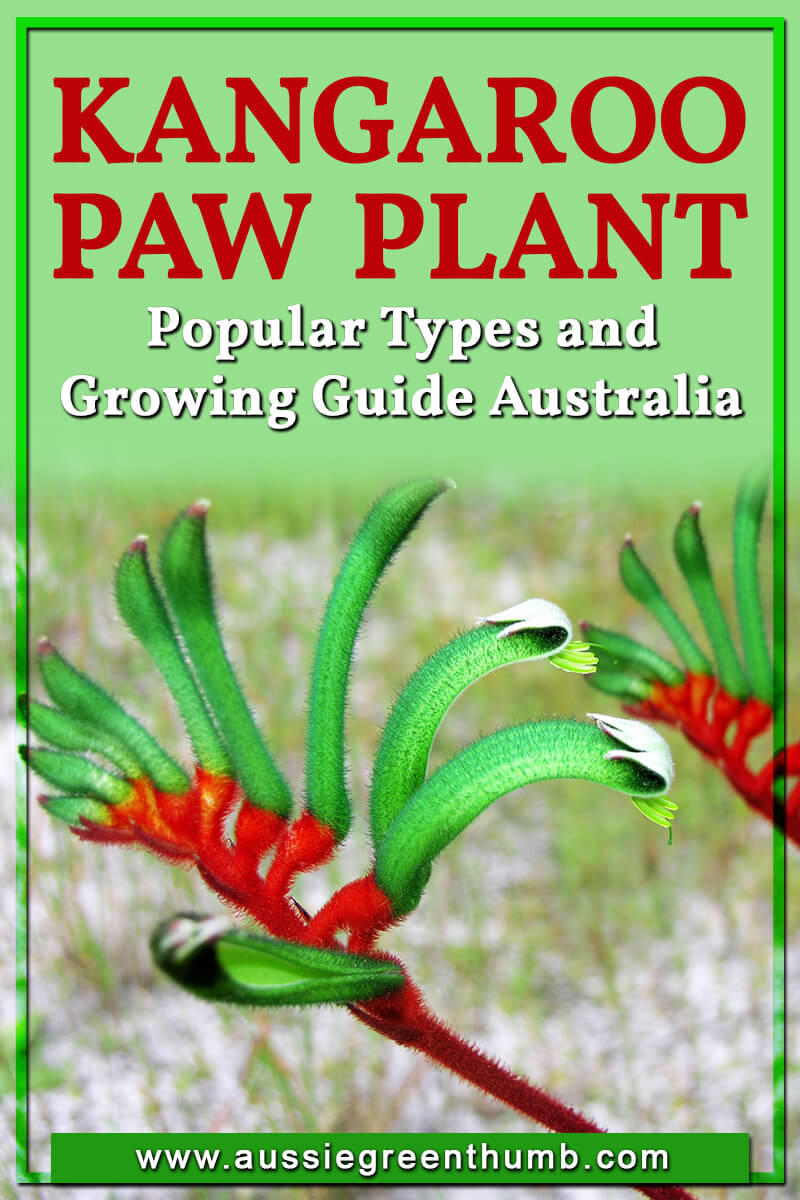
Add Unique Australian Beauty to Your Garden with Kangaroo Paws
Because it’s a native Australian plant (see more Australian native flowers here), Kangaroo Paw care is easy even for less experienced gardeners, creating a beautiful backdrop of vibrant colour through spring and summer, and attracting birds, bees and butterflies to your garden.
Drought and semi-frost resistant, this plant requires little in the way of fertiliser – just make sure your soil drains well, that it’s planted in full sun, and that you give it a heavy prune each year in the early autumn.
If you need any help with Kangaroo Paw plant care or how to prune a Kangaroo Paw, just refer back to this guide.
Published on June 28, 2022 by Lorri Hopkins
Last Updated on February 25, 2025





My 2 small bush gem kangaroo paws are not looking two good since i pruned them right back as suggested after flowering. Can I use any fertiliser on them or just let them make their own way back. Hoping you can help J. A.
Could you take a photo and send it my way?
You can absolutely fertilise them and they ‘should’ come back looking good now with the spring season. Just make sure you use a native fertiliser as Kangaroo Paws are very susceptible to phosphorous.
I have a Red Kangaroo Paw. No idea what the name of it is. I have it growing in a very large pot in full sun. I live in the Lokyer Valley in Queensland and have had the plant for just on 12 months now. Since planting it has flowered prolifically and constantly even during the flooding of early 2011. It is now about 1 metre tall and about 1 metre circumfrance. We have very mild winters here and no frost. Summer is very humid and hot, yet it keeps flowering. I cut back the flowers as they fade. Should I just keep doing this or should I be more brutal and prune it right to the ground? I don’t like to think that I may ruin what is a beautiful and prolific plant.
To be honest it *should* be fine, but I can’t make any guarantees.
What you might like to try is a happy medium. Perhaps gradually trim it further after each flower? If it is getting too big, you’ll need to trim it anyway. Just trim a little more off each time until it is back to what you’d like it to be. This would be the safest bet.
Hi I didn’t know about this pruning thing and have just left the long stem and flower on after it faded last autumn. It is now nearly NOvember…is it too late to prune it? It is on a west-facing balcony in the middle of Sydney. I’ve started fertilising it with organic fertiliser (fish-based), is that OK too?
Not too late to remove the old flower stem but I wouldn’t give the rest of the plant too much of a prune. It won’t hurt to have missed it, just wait till after this seasons flowers and prune it properly afterwards 🙂
Hi, I have just moved into the SOuthern Highlands south of Sydney. I have about 6 large Kargaroo Paws plants (Red, Yellow and green). They have got to big in their current location and I would like to relocate them. I moved two to the front garden from the back, whilst in flower, it looks like they have both died. When can I relocate the others?
Hi There gardener, I have just cut down my flowers off my paws and now i wounder should I fed them some food ??????? Im in Geraldton WA what is your best thoughts…….. thanks
Hi there Aussie thumb I have just cut down the flowers off my paws, should I give them some food or wait for the cooler weather….. Im in Geraldton WA thanks for your comment……..JO
If they’ve finished flowering, which is sounds like they have given you have cut the flowers off, now would be a fine time to give them a light feed with a good native fertiliser. 🙂
Hi We have just moved to a new house in Wilton NSW and are planting our native garden. We have put in Kangaroo paws and some still have flowers on them, is it too early to prune them back hard as they have only been in for a week.
I’d leave them a while to allow them to settle into their new environment. Trim off any flowers when they die but other than that, don’t be too harsh on them. After the next flowering season you can give them a stronger prune.
Hi there… we have a couple of kangaroo paws in our garden as i absolutely love them… reading the above it sounds like it might be too late for me to prune them back this year…? Should i wait until the of the next flowering season or would it be okay for me to prune them now – albeit late? we live in Perth… Thanks for your advice… Cheers, Sally
when is it the best time to repot your kangaroo paw ?
Hi there, I live in Johannesburg in South Africa. I was given a beautiful red Kangaroo Paw (sadly not sure which one) in a pot as a gift a few years back and it flowered profusely for 2 years and then just stopped! Still has lush foliage, though.
We have dry, cold winters with frost (around 5 degrees Celsius in mid-winter, but can drop below freezing) and wet, hot summers (25 – 30 degrees Celsius).
I have never pruned them and suspect that, that could be the missing clue. What do you recommend? Is it too late already (today the high was around 17, but it will get down to nearly freezing tonight). Am I too late to get chopping now?
thanks
I wouldn’t be pruning it now with frost being a possibility. Wait until spring/the warmer months get closes, then give it a light prune to encourage growth (and hopefully flowering) this summer!
It may also need a good fertiliser to get it going. Make sure you use one low in phosphorous because Australian soils lack this and therefore Aussie plants are not used to it in high doses.
Hope that helps!
Wow thanks! That really helped to at least give me an action plan. Will hold out till September..
How long before I can expect flowers from healthy seedlings of Anigozanthus?
I’m afraid I have never actually grown Kangaroo Paw from seedling. Did you buy them from a native nursery? I’d ask them. If not, just look up a native nursery in your area (preferably one that grows their own stock) and they should be able to help you out.
Sorry for the slow reply, this comment slipped through!
By now you’ve probably made a decision but it would have been ok to give it a very light prune then. Making sure dead foliage and flowers removed is fine any time.
I am from California and just planted some kangaroo paw plants. The all have long flower stocks that are about 3-1/2 feet high. many of them have fallen over. Is it OK to stake them until they finish blooming? Once they finish blooming, do I prune the entire stock back to the green leaves?
Hey,
Absolutely it is fine to stake them till they finish blooming, though I am surprised to hear they are falling over? None the less, that will be fine.
When this happens yes, prune the spent flowers off right at the green leaves 🙂
Hi,
I have 3 kangaroo paws and am experiencing a problem with the flower. They grow up to the point that they look as though they should be about to open. Then they seem to dry out and die before opening.
I live in Sydney. They are planted in a sandy soil in a position where they are in sun throughout the afternoon. I am giving them plenty of water but not too much.
Thanks for your advice,
Michelle
Hi I have 2 kangaroo paws in my garden after they flowered I cut them right down to the ground as tolde by 2 of my work colleagues and they have not shown annsigns of greenery or look like they are gonna gro again. Could you please give me any ideas on how to get them up and growing again!!!!
Hi there. I am from Canada. I bought my Kangaroo Paw plant about three years ago. What I am wondering is will it eventually adapt to summer /winter here or does it keep summer /winter seasons of its origin? I seem to get flowers at any time It flowered in the beginning of April. But it has also flowered in October. I do have problems with die back. Is that normal? Also , I read that it can grow very large. I have been keeping it in 6 inch pots, and it is a nice manageable house plant, but if it does grow bigger I would like that.
Hey, great to hear that someone as far North as Canada is giving a Kangaroo Paw a home.
It should adapt to the seasons that it is growing in. It gets cues from the weather as to what is going on, so in that regard it should follow the Canadian seasons. However, it is not uncommon for them to flower in spring and autumn (what you described) as opposed to summer, depending on the conditions.
Depending on the variety they can grow very large but it really depends on the variety. There are also quite a few small varieties. It wouldn’t hurt to try a bigger pot to see if that allows it to grow more. How big are the flower shoots usually? That would give some indicator. The big varieties usually have really big flower shoots.
The flowers grow on 10-inch stems, and the flower is like a paw spanning about 2 inches. Leaves are maybe about a foot long and half an inch wide. I have to say I just love it and everyone who sees it in bloom is taken by it too. We don’t have anything like it here. Sounds like I may have a small variety.
Hi, I transplanted a lot of kangaroo paws just over a year ago and of the 40 or more roots most survived. Several, 12 or more, flowered and I left the flowers on until a few weeks ago as the birds used them as perches so that they could have a good look around before drinking from the bird bath. I now have a good bed of kangaroo paws and the leaves have brown tips but otherwise look healthy.
My questions are:
1 Should I prune them now?
2 If so then how hard?
3 When should they be fed and what should I feed them?
Hey I asked my local native plant nursery how to prune my kangaroo paw.in Autumn. He told me to run the mower over it when mowing the lawn.
Result That was three years ago and never saw a leaf since.
Good one I really did want it.
Hello…question please…I have noticed that this year my kanga paw has developed some sort of new foliage on a flower stem that I didn’t get round to cutting off. It looks like a baby kanga paw. How can I propagate these ‘growths’…have tried unsuccessfully to cut them off and pot them up but they all died….still got a couple left though and would like to try another approach…any advice please.
Hi there,
I’ve just pruned off the dead flower stalks (monsters that they were!). I know this pruning was a bit late… it was a matter of “I’ll do it next weekend.” Is it also too late (21st May) to give the rest of the plant a good prune? They are starting to look a bit scruffy with a lot of brown tips and I’d love to clean them up. I am also hoping to split one of the bigger ones to replace one that had died. Will this be ok now too? I’m in Melbourne. Thanks
Hey Katie,
Nice work with the pruning, always good to hear that gardeners out there are getting their hands dirty so to speak and looking after their plants, although it sounds like you are pretty much in control just not enough time on your hands!
The plant should be fine at this time of year as long as you give it a bit of TLC after separating i.e. don’t just forget about it or leave it til next weekend to check on how it is taking 🙂 Good luck with it and I’d love to hear back from you in a couple of months just to see how things are going, send through some photos if you like and I’ll post them up on the website as a bit of a guide for others, if you’re interested.
Cheers
I live in foothills of Adelaide – north of the city – have just moved and put in a kangaroo paw in 2013 and it hasn’t stopped flowering! it is in a north facing position in full sun and even the frosts haven’t hurt it. My other attempts of growing them have always failed!
Why would my red kangaroo paw turn yellow?
Sounds like you are onto a winner there Anne!
I just saw the same growths on one of my Paws too. Can these be cut and planted as a regular plant? I saw no one answered this qy, but glad to see someone else has seen it.